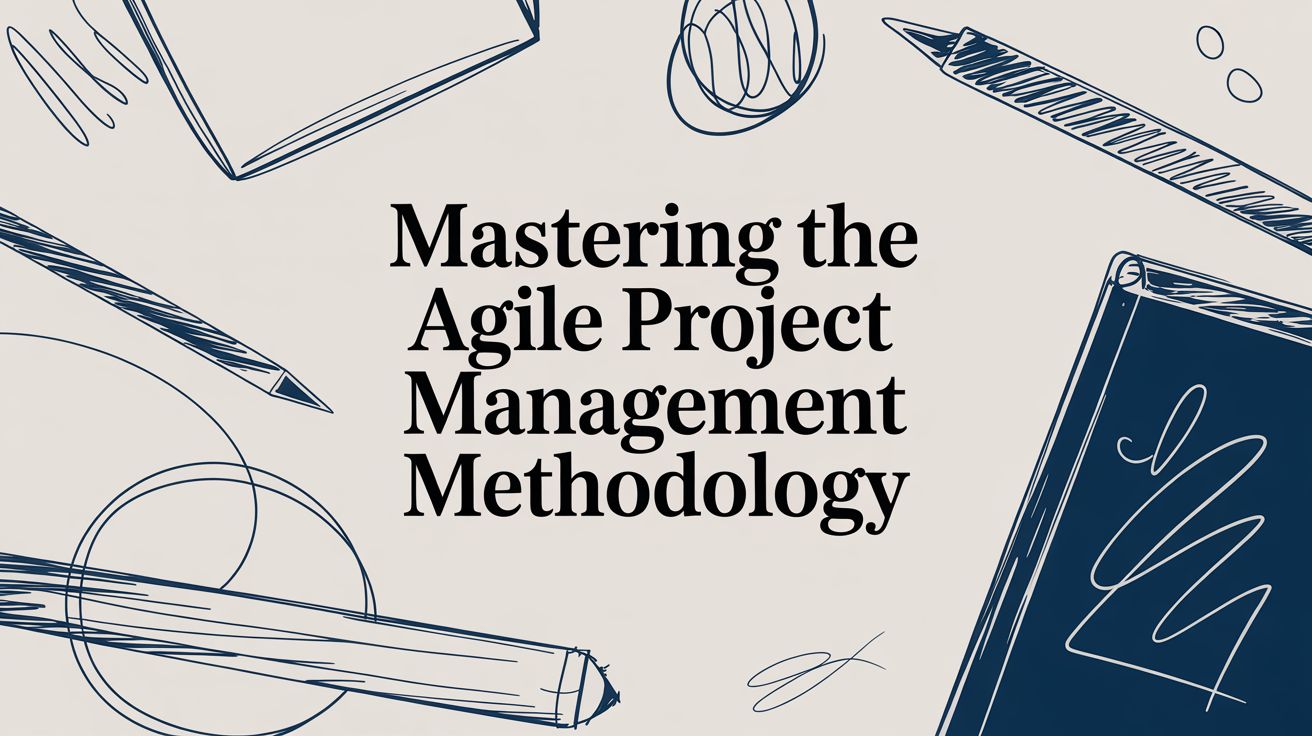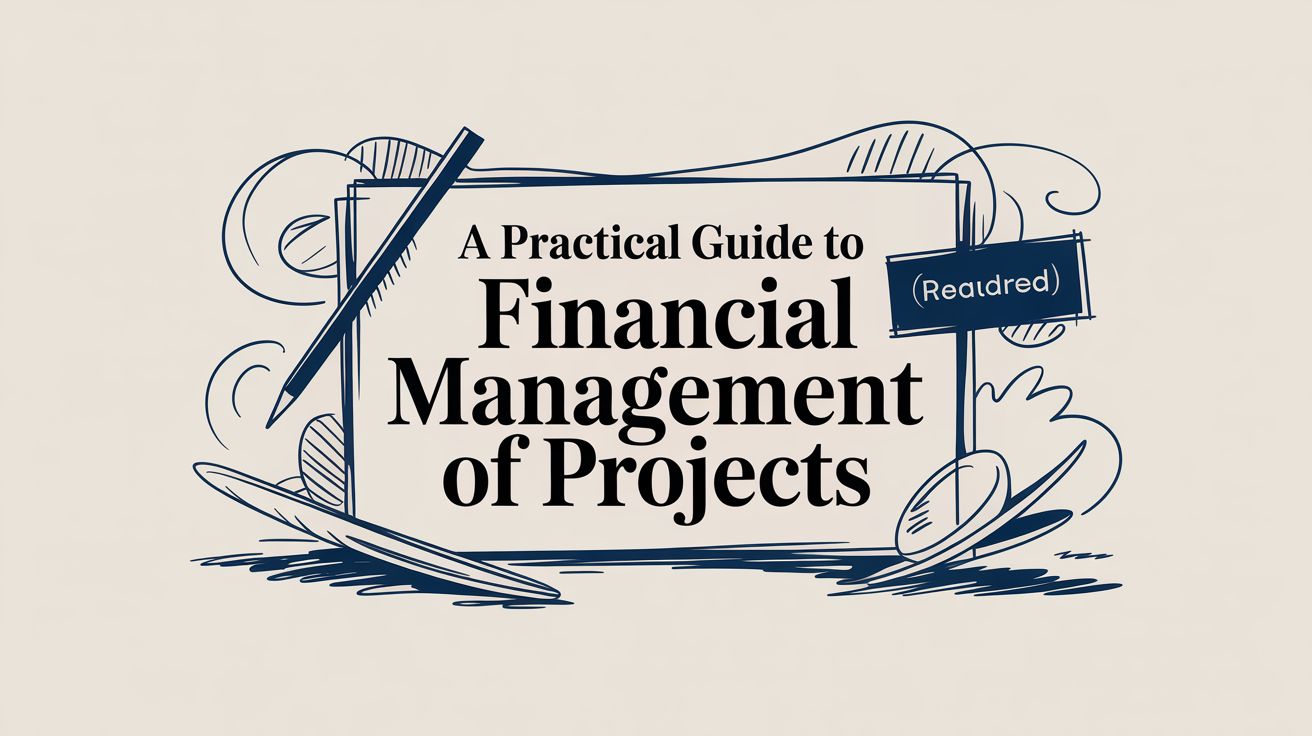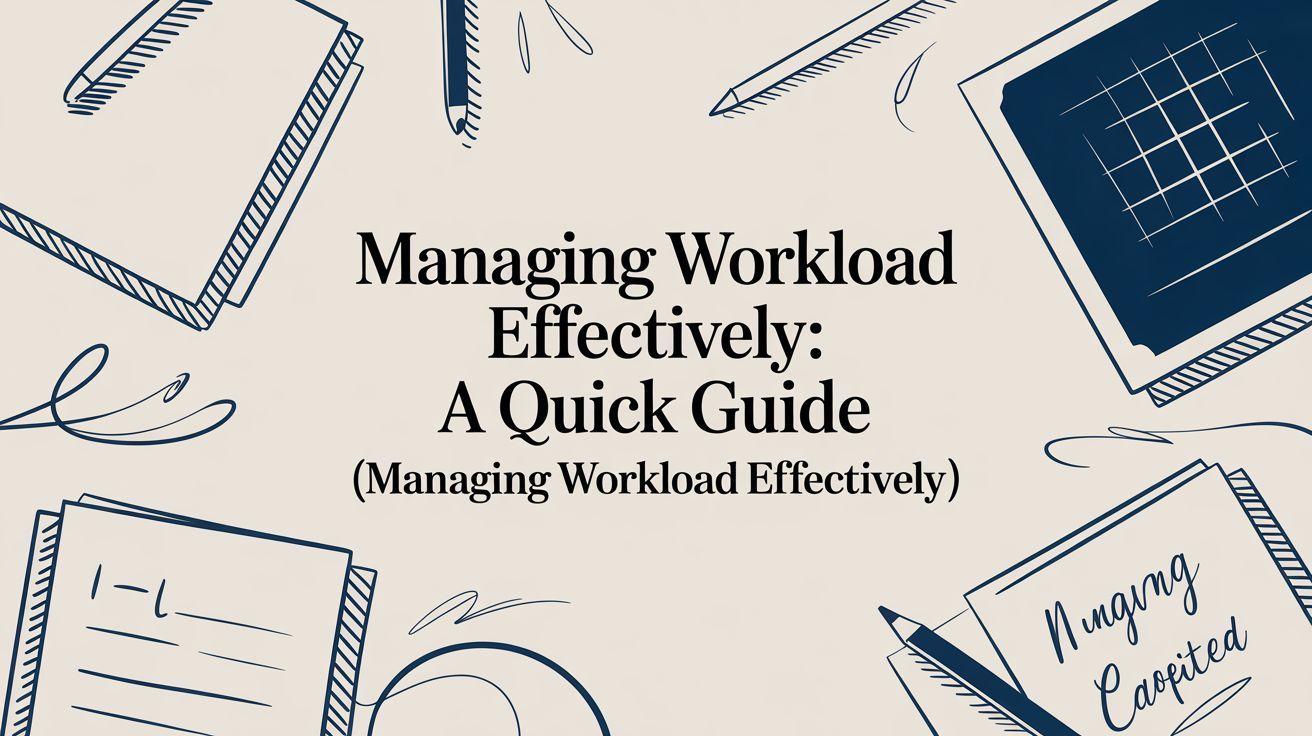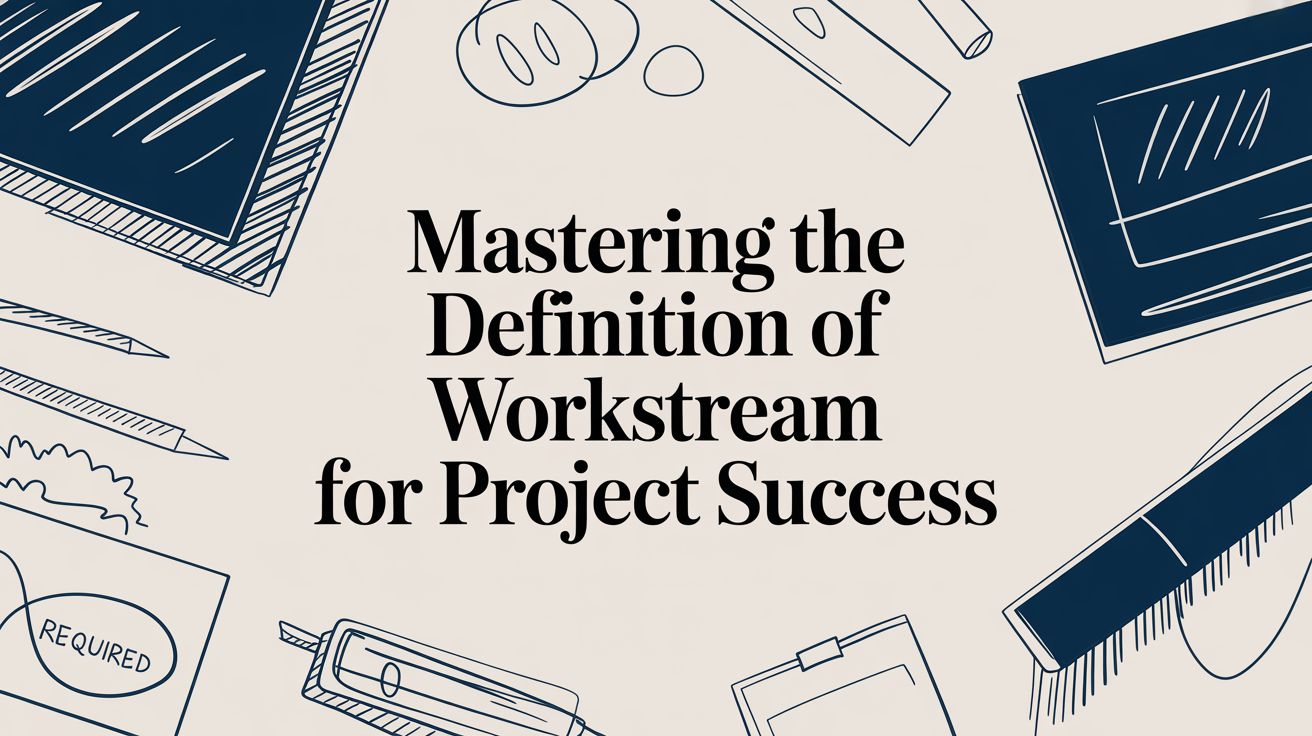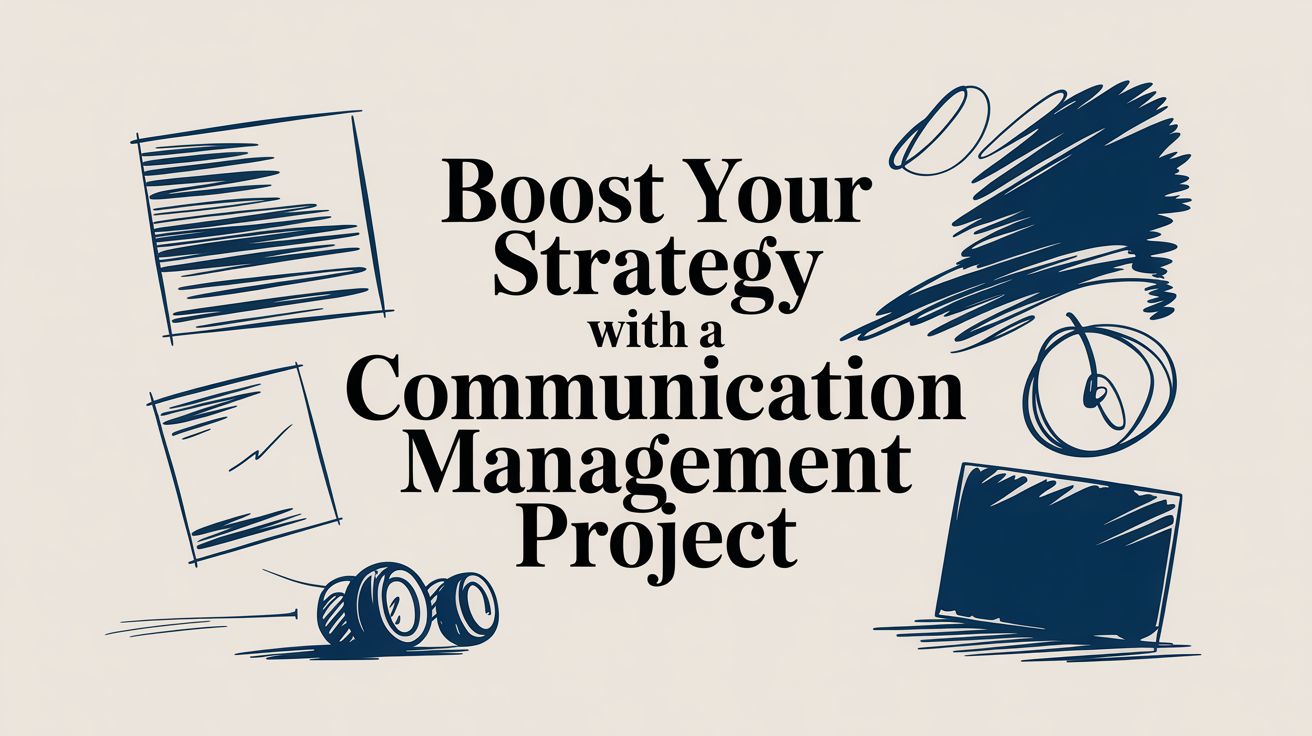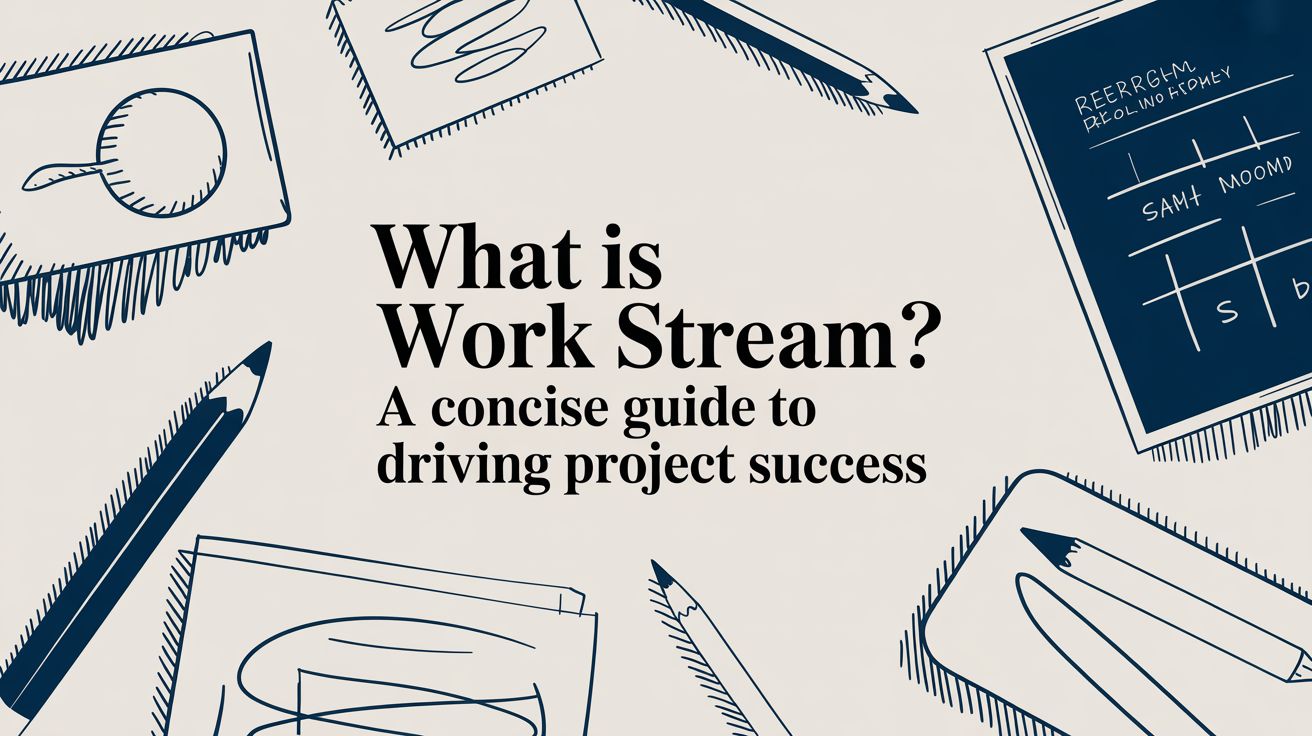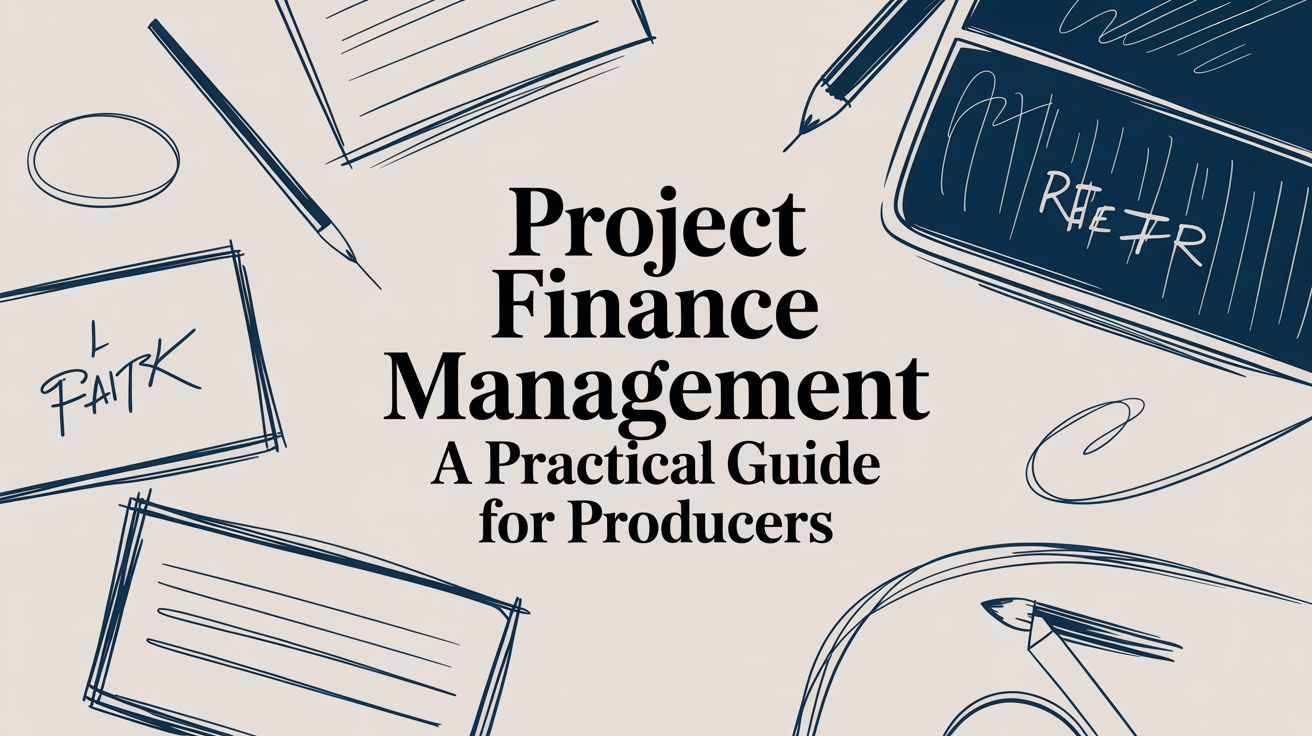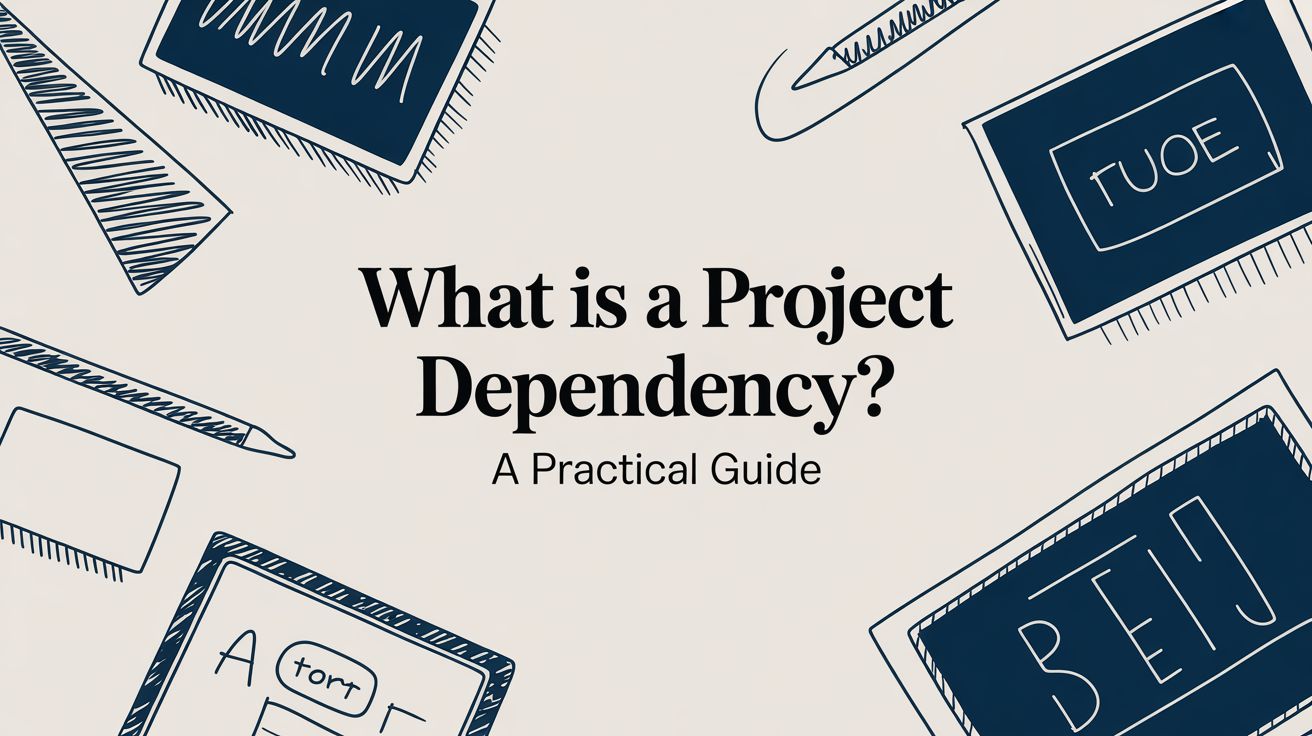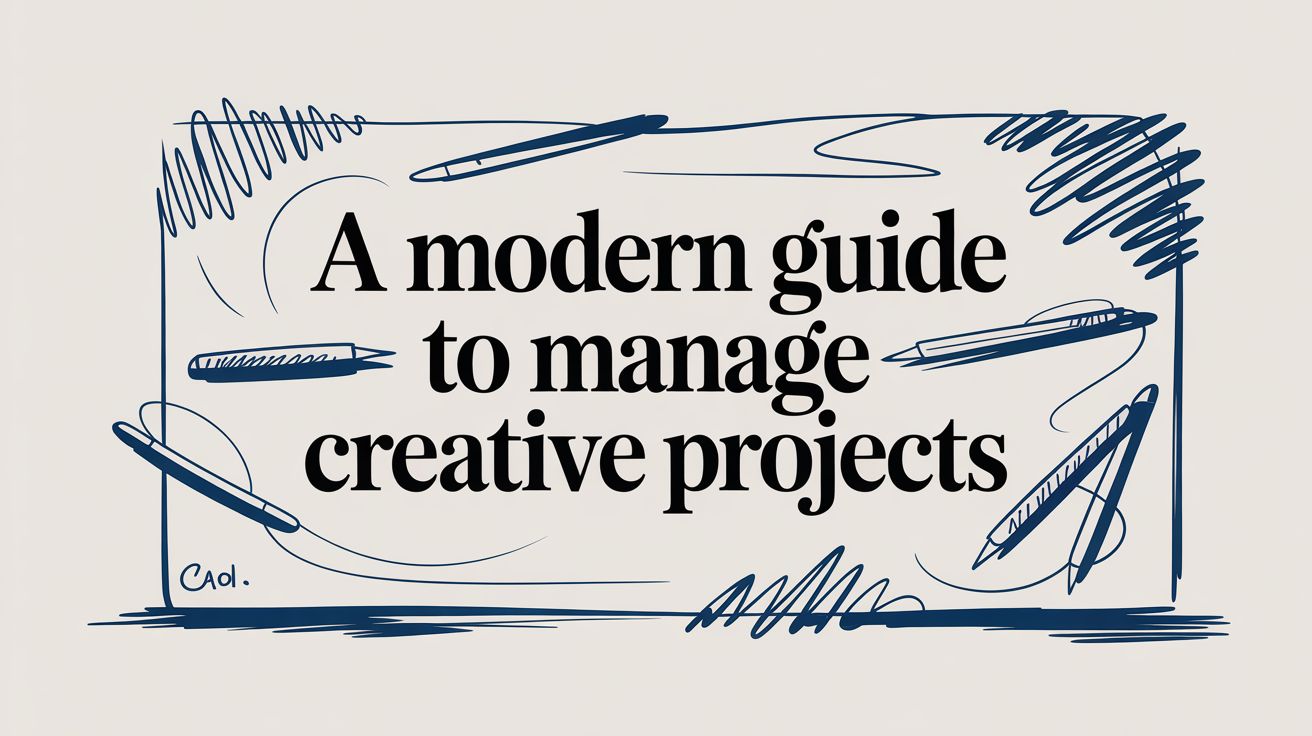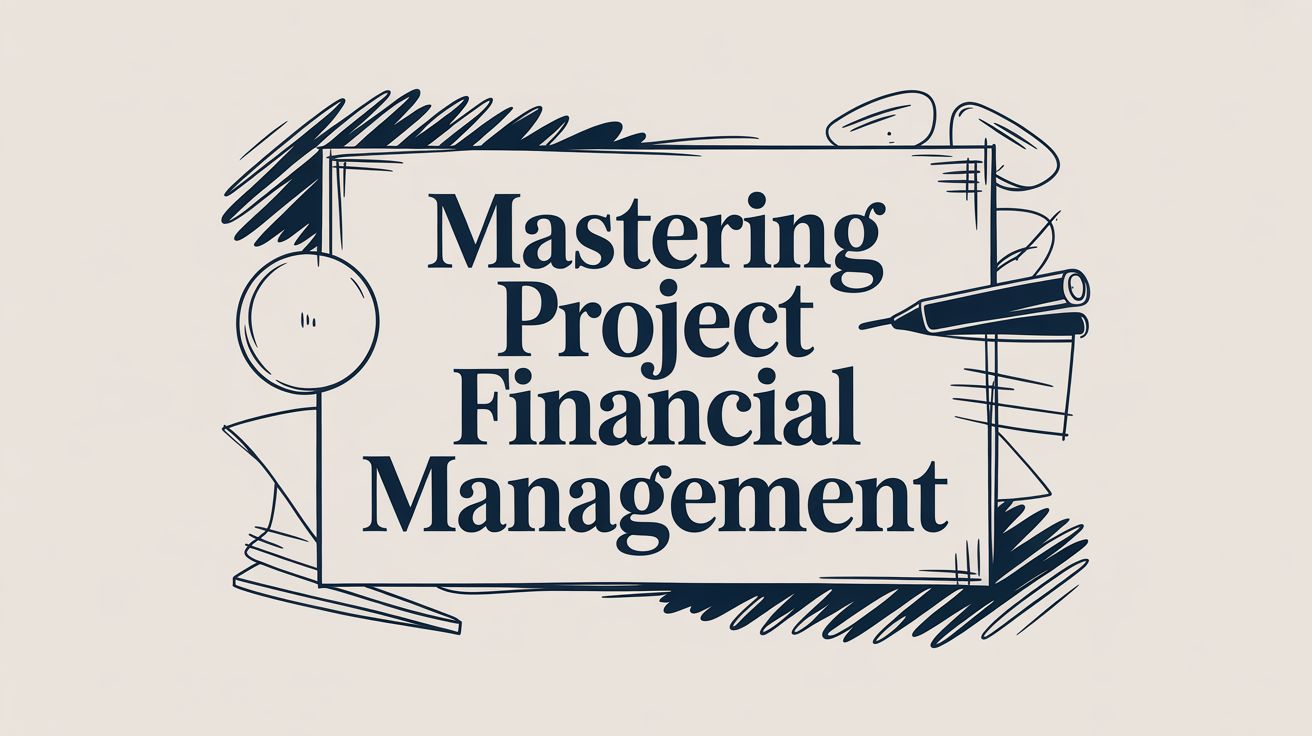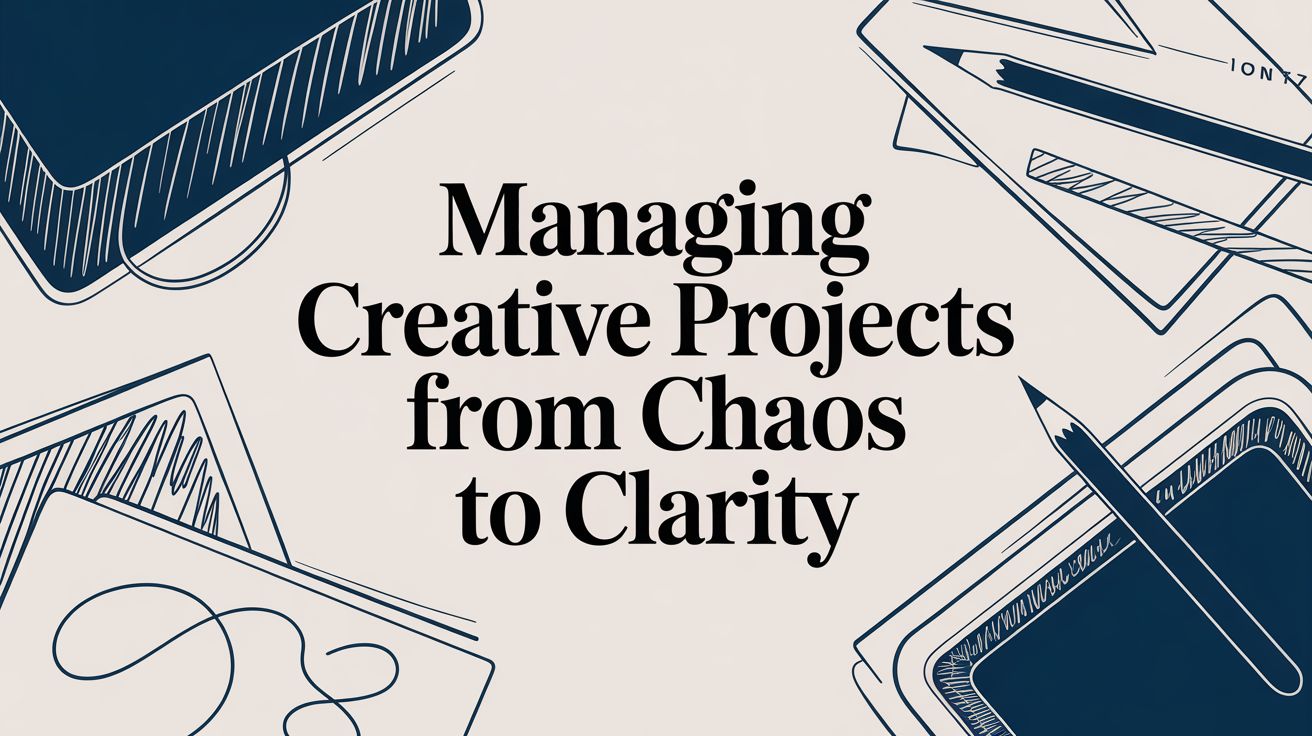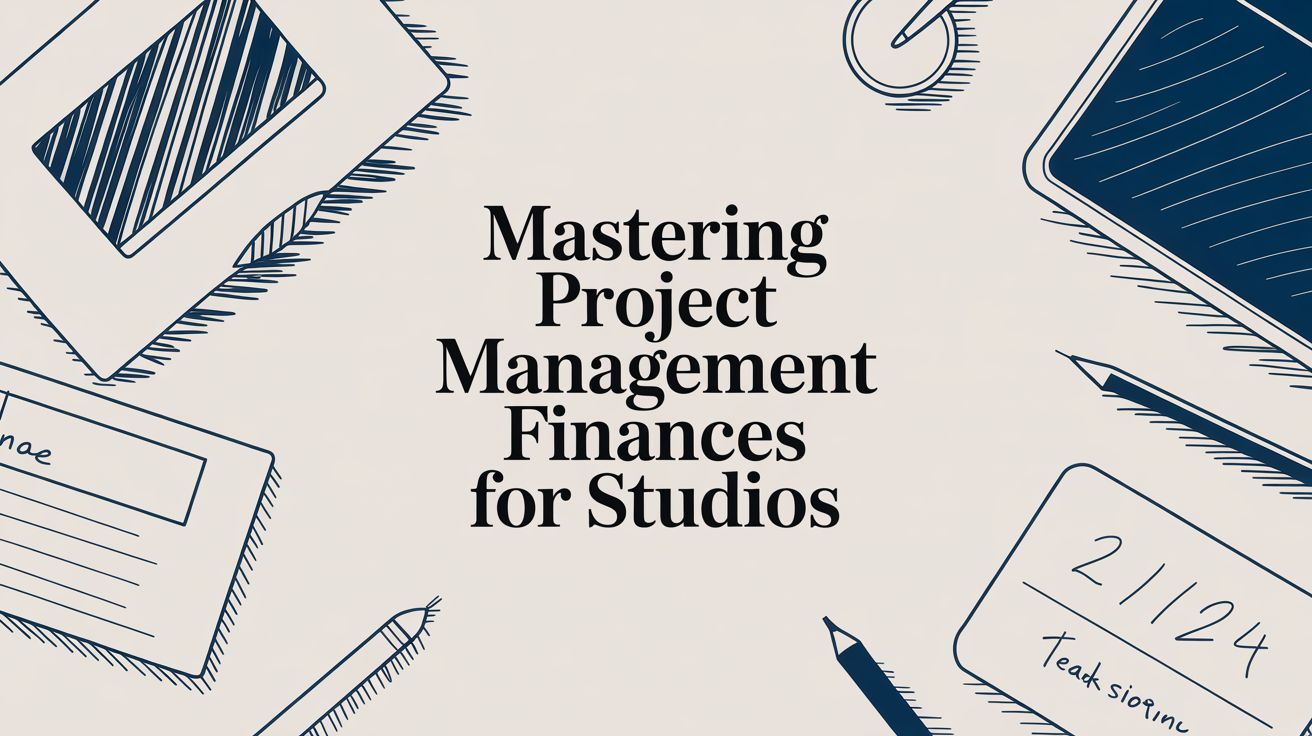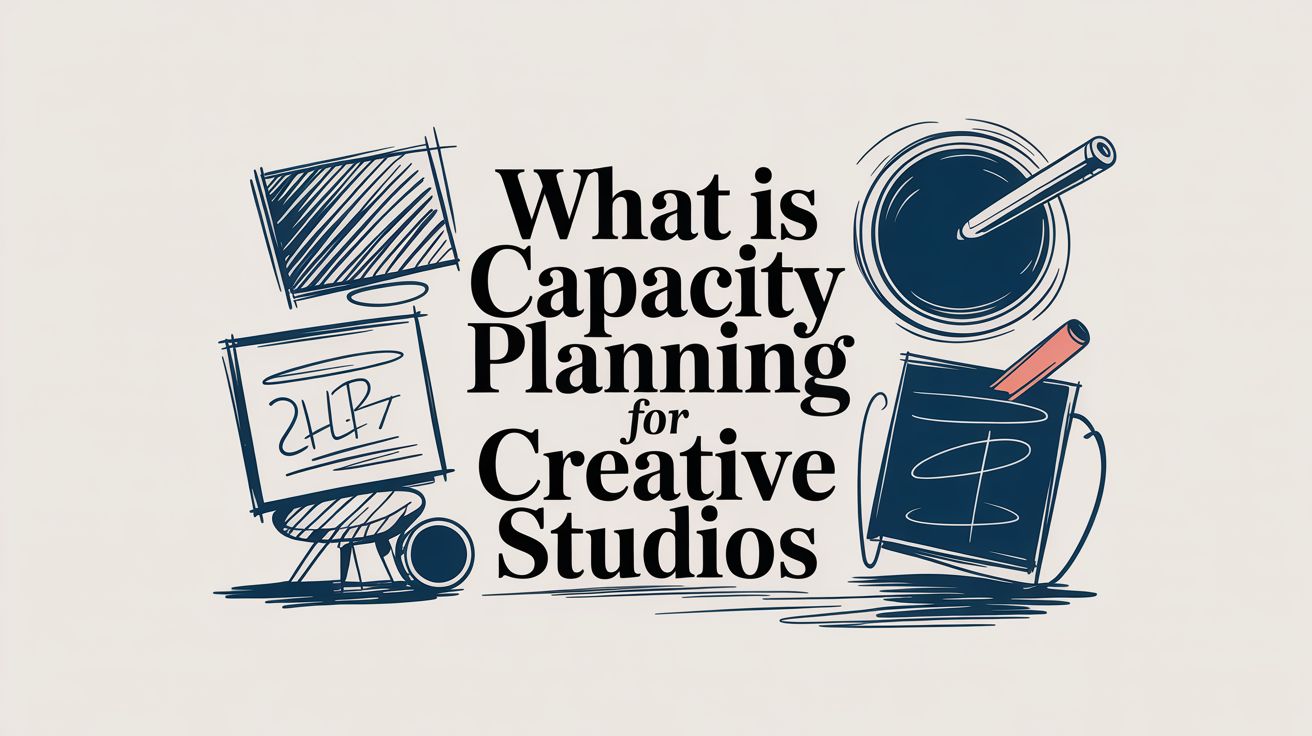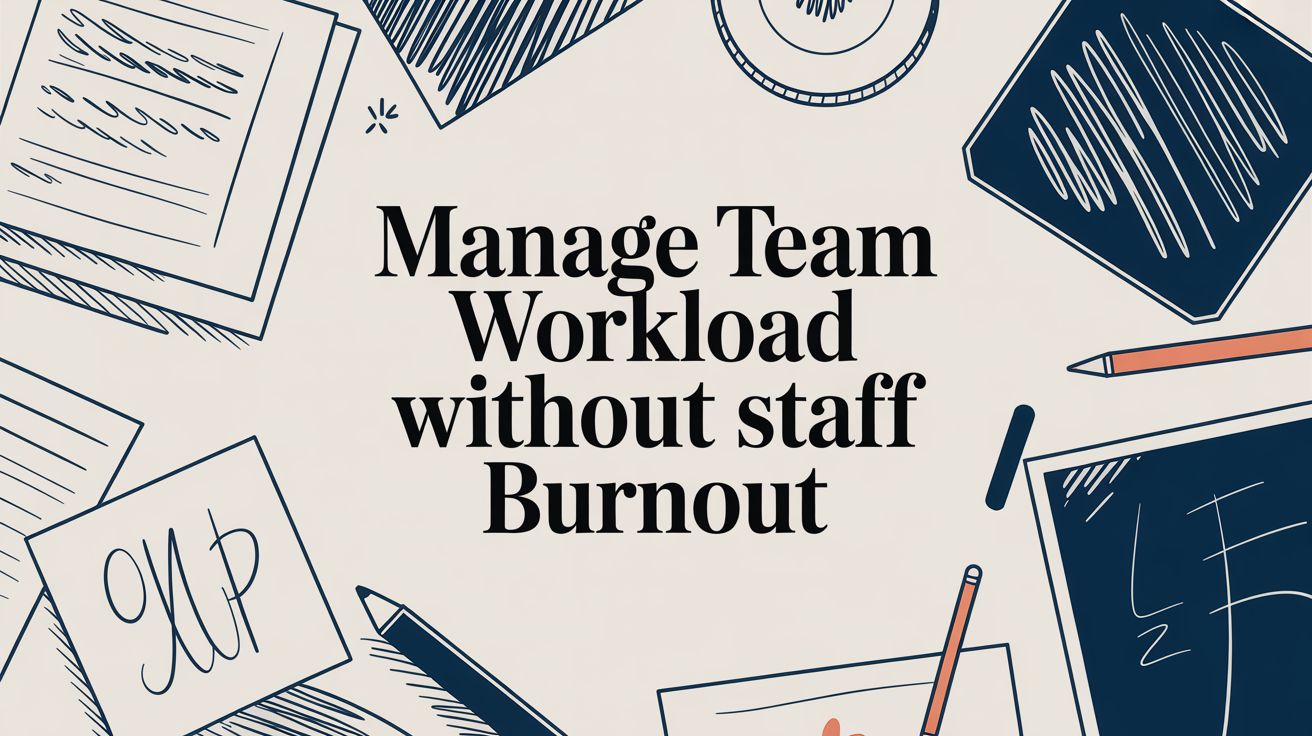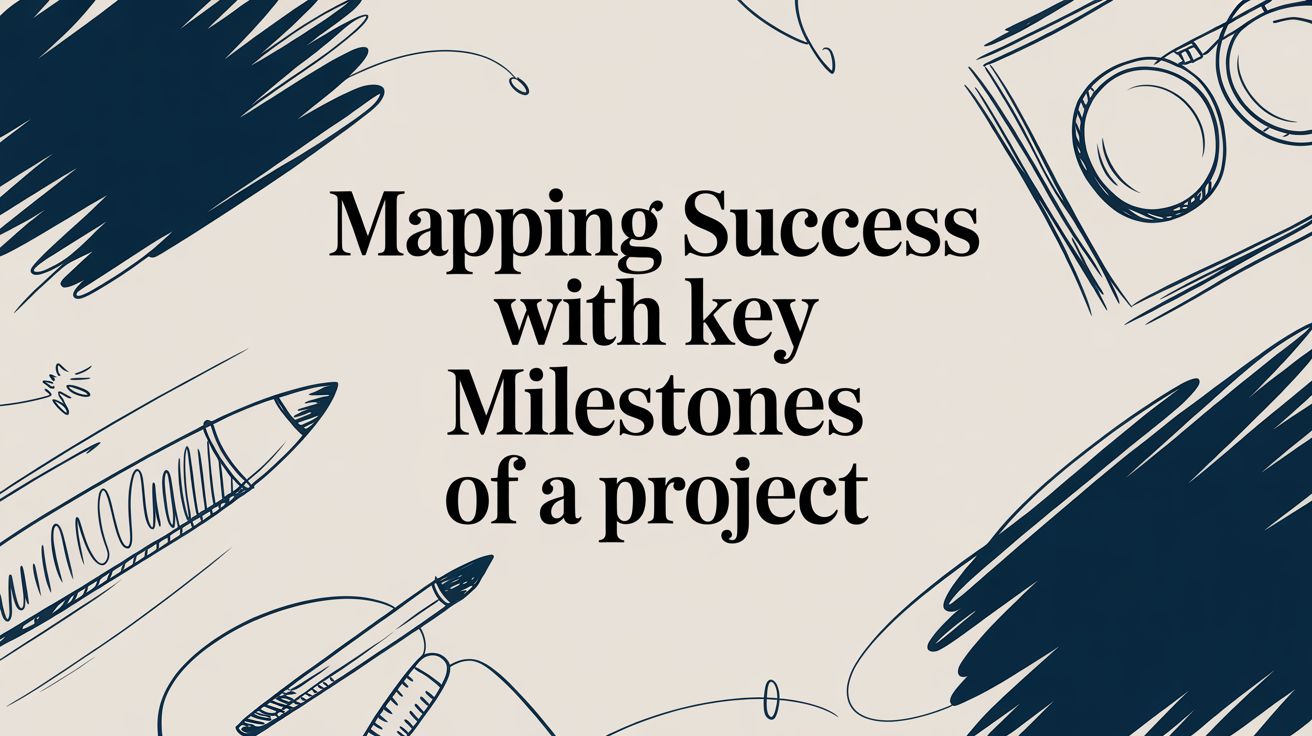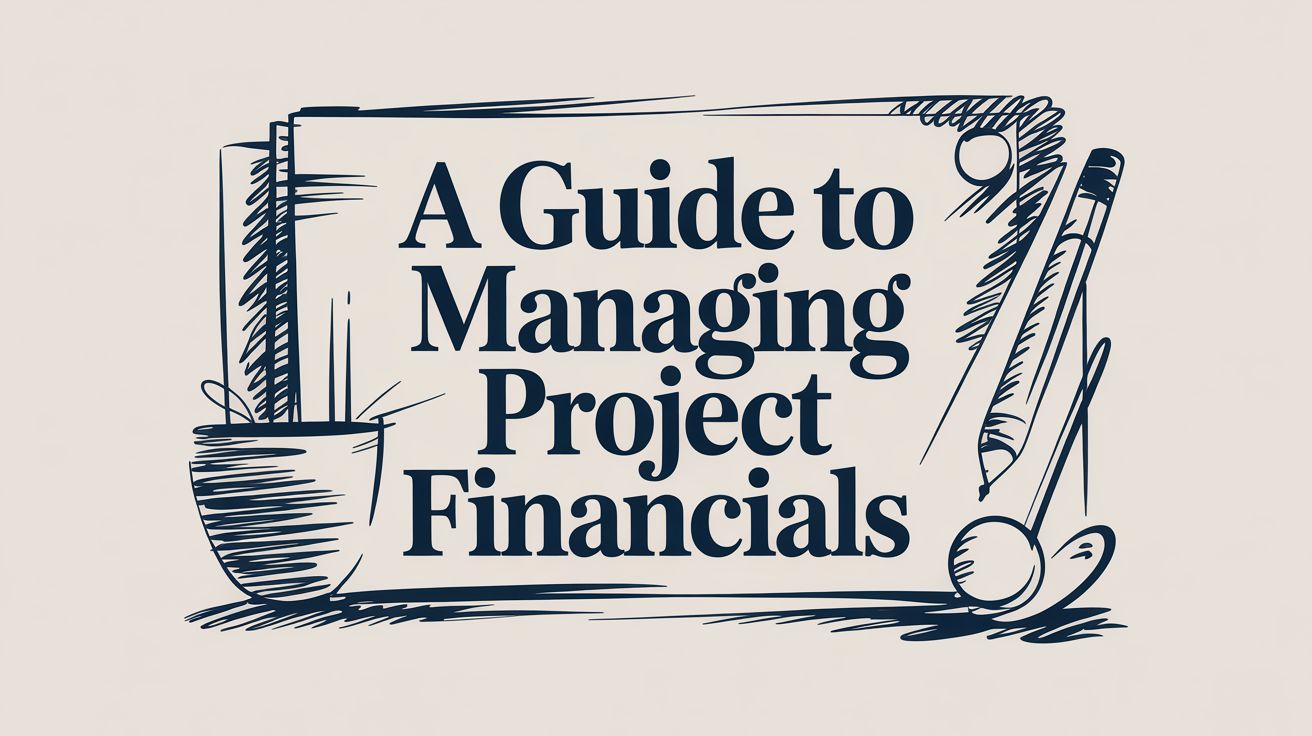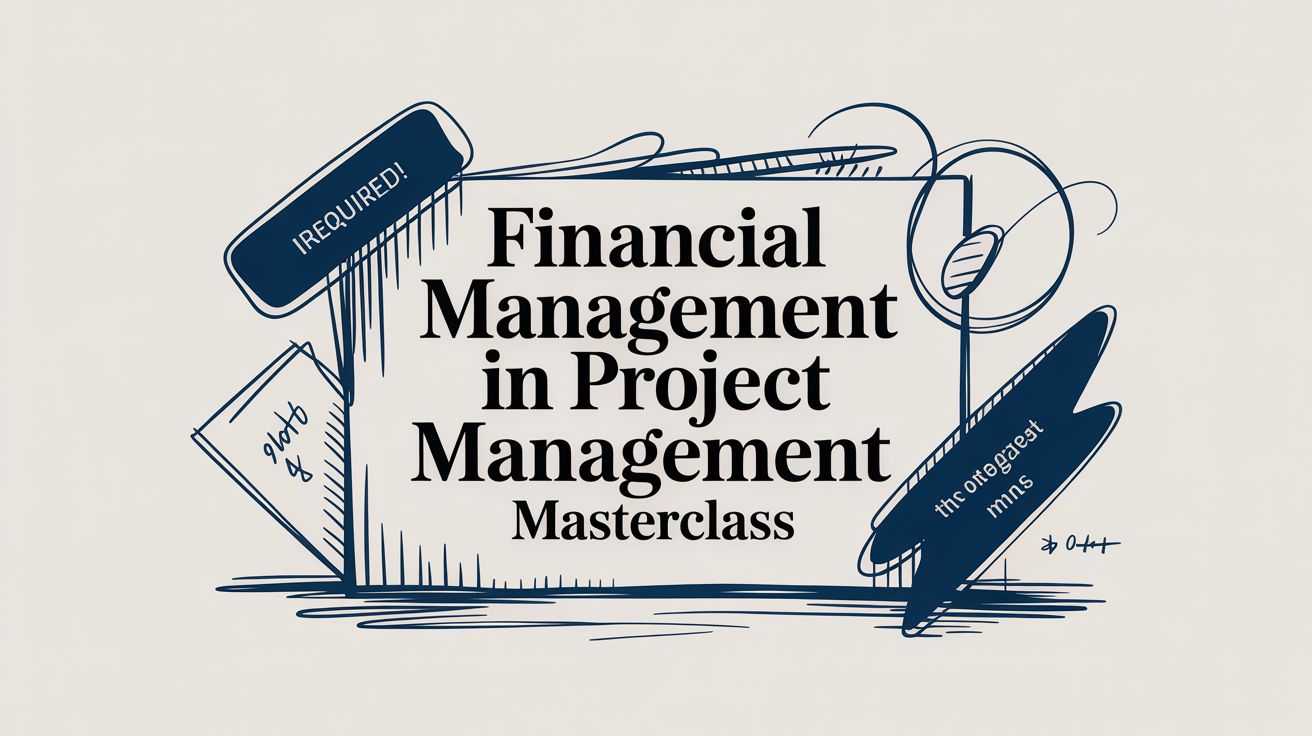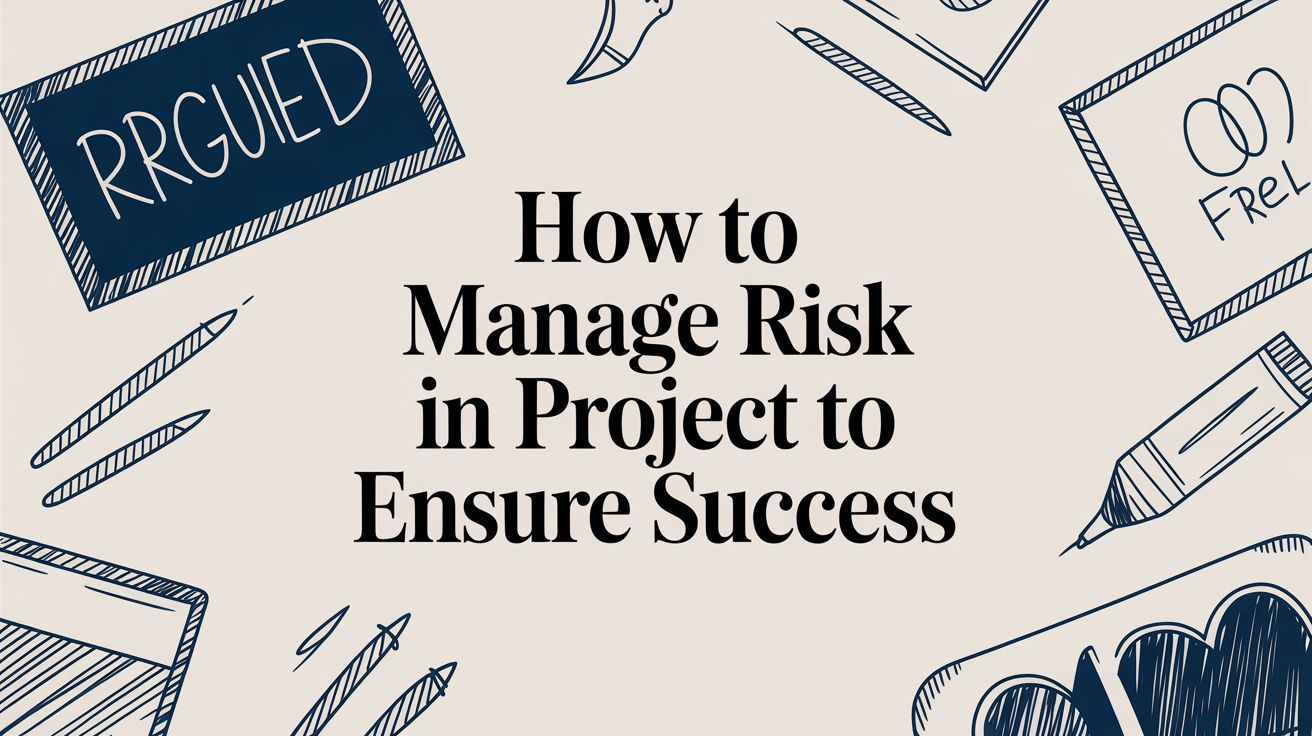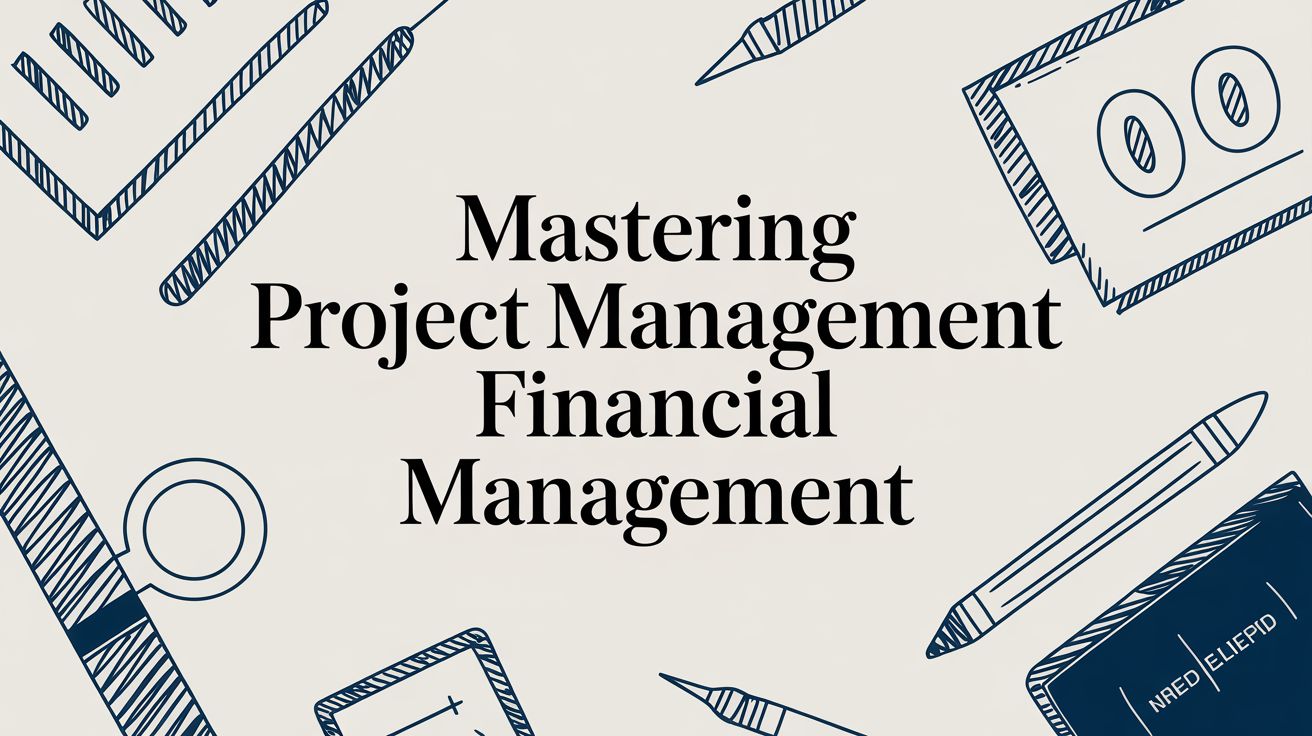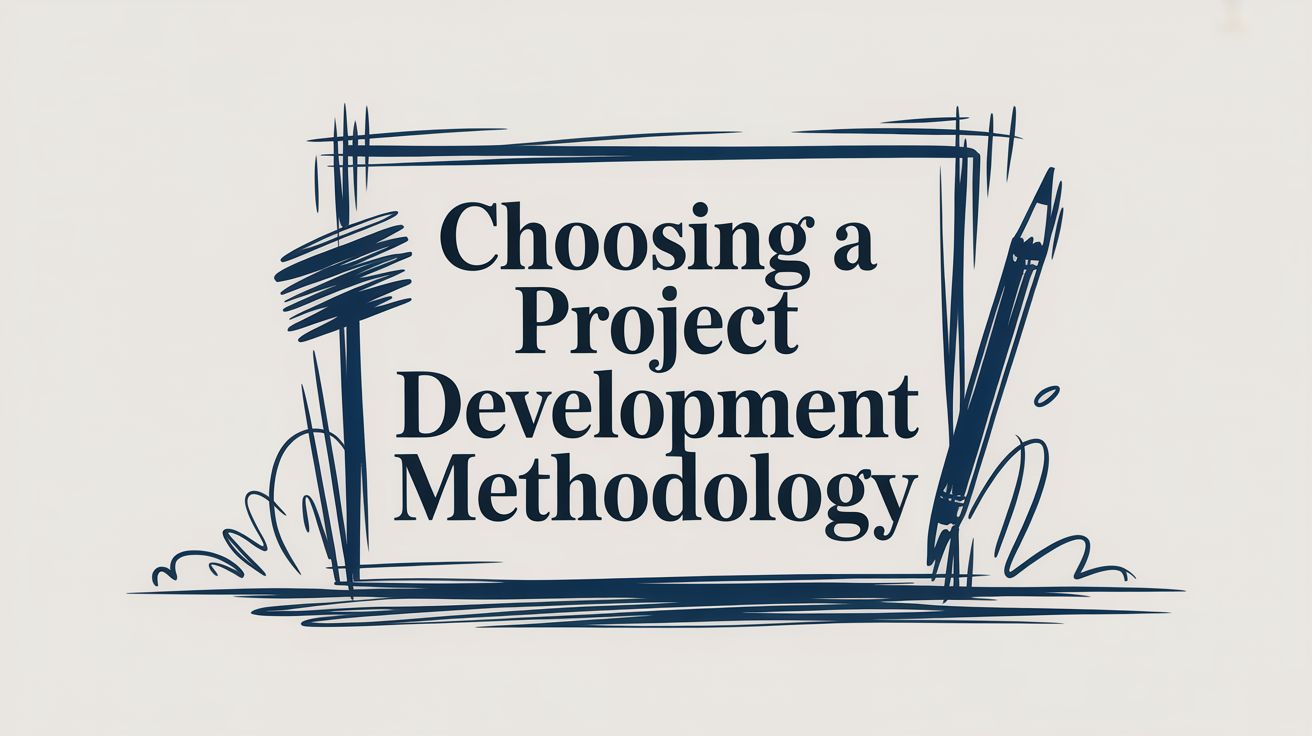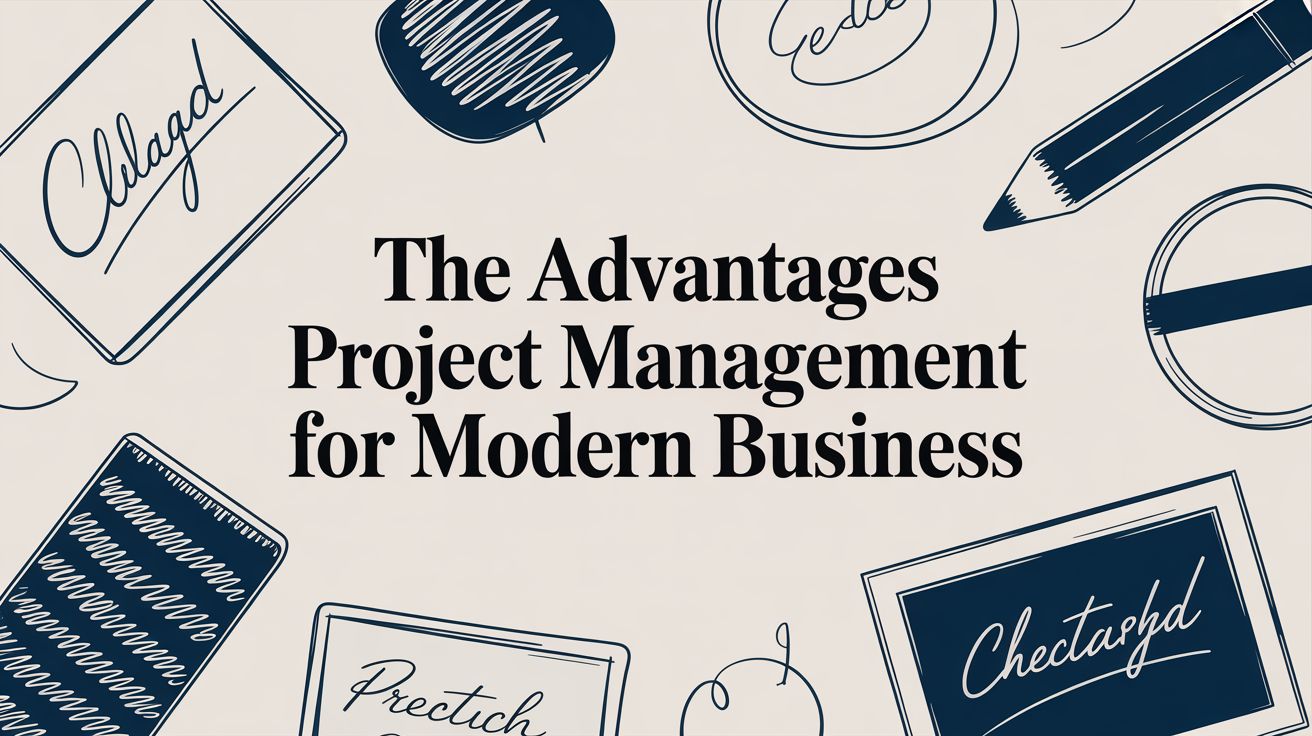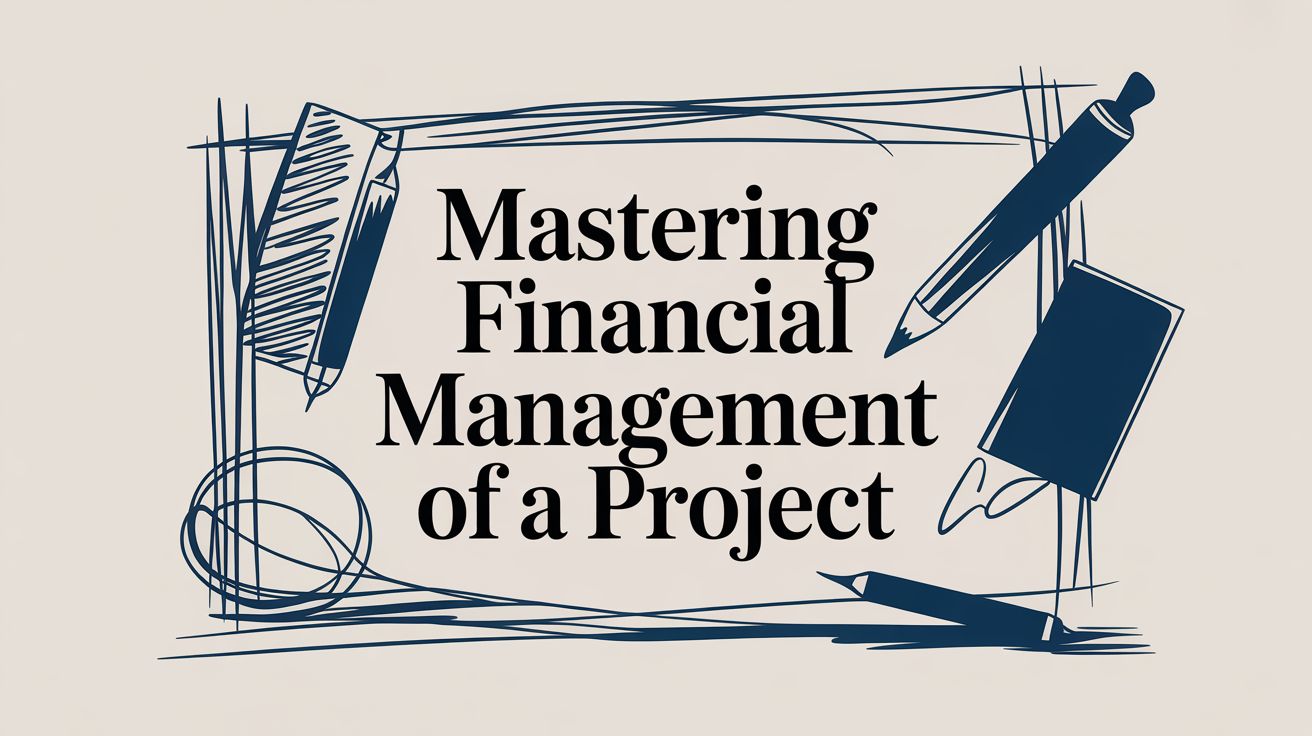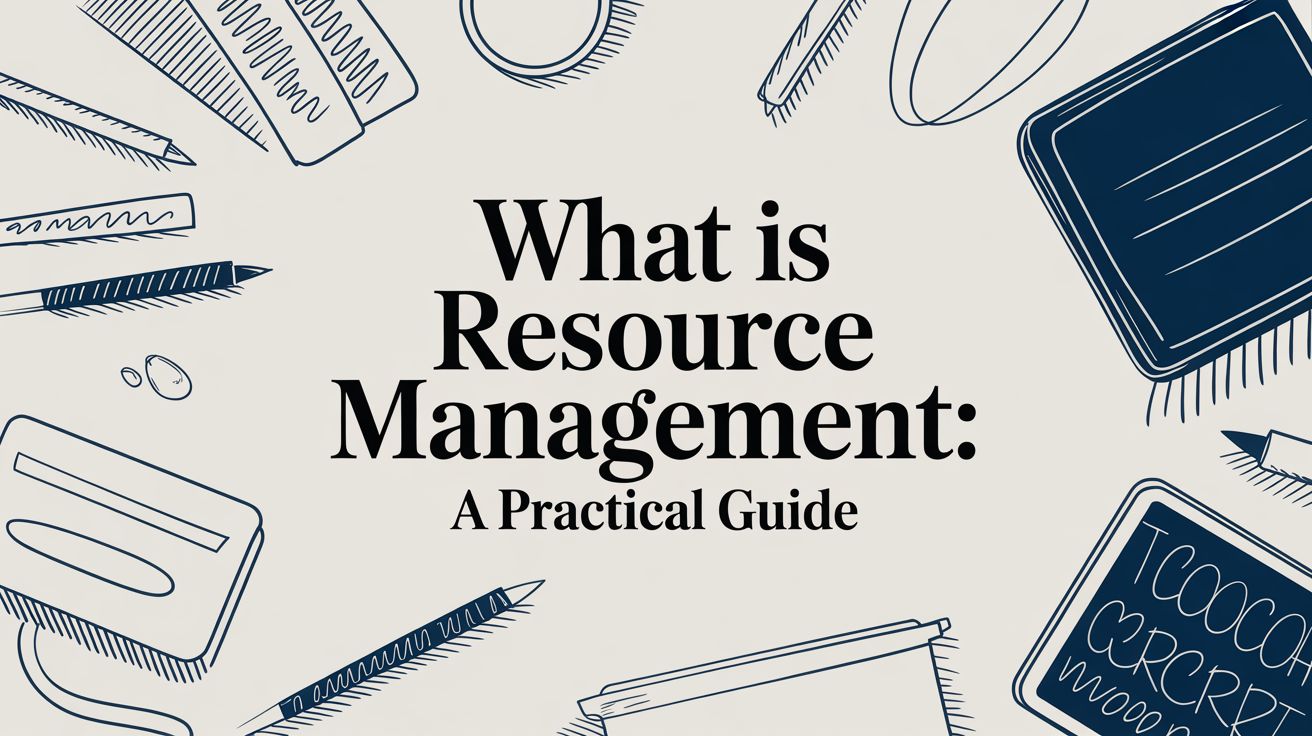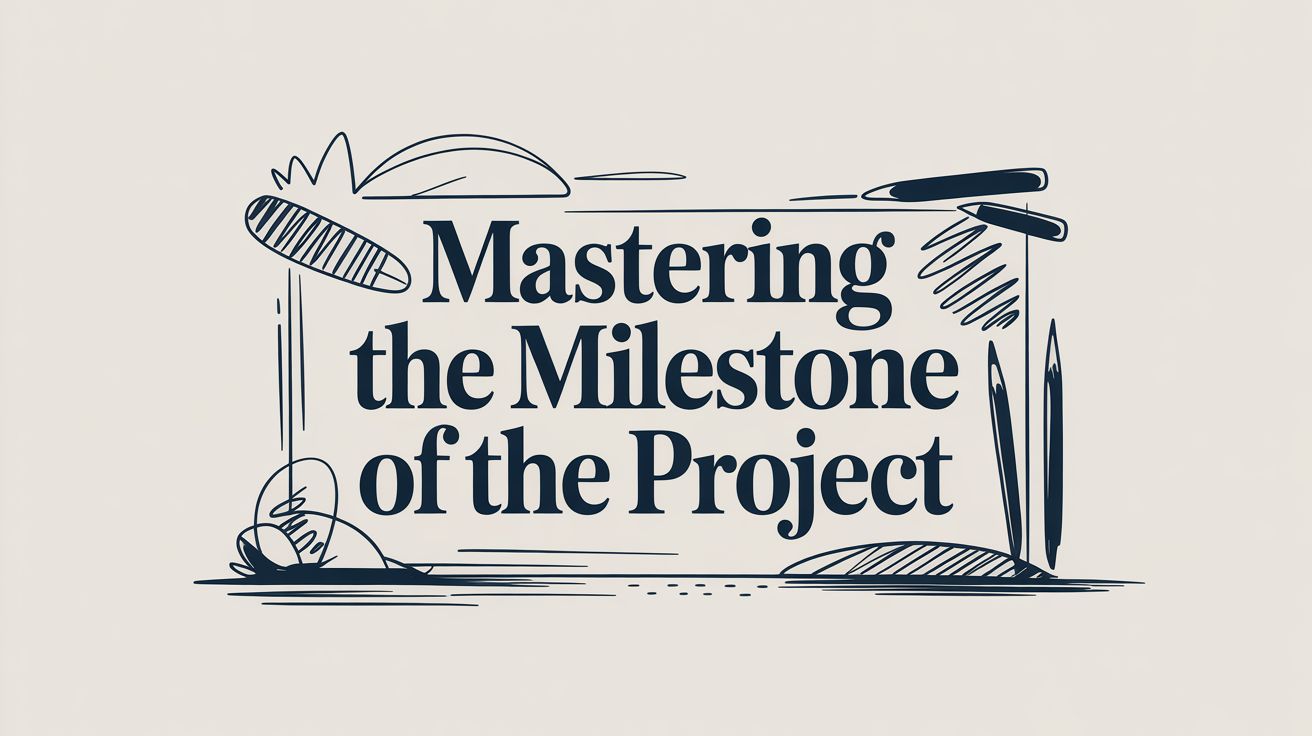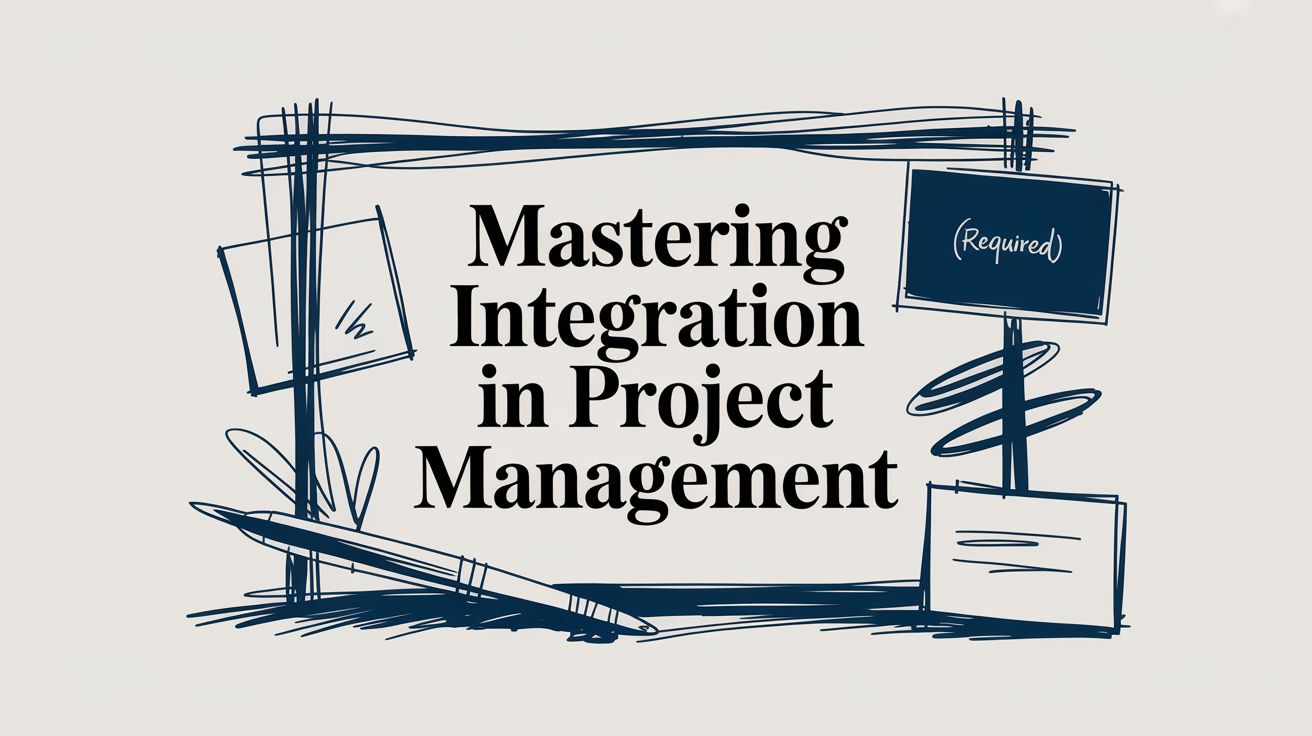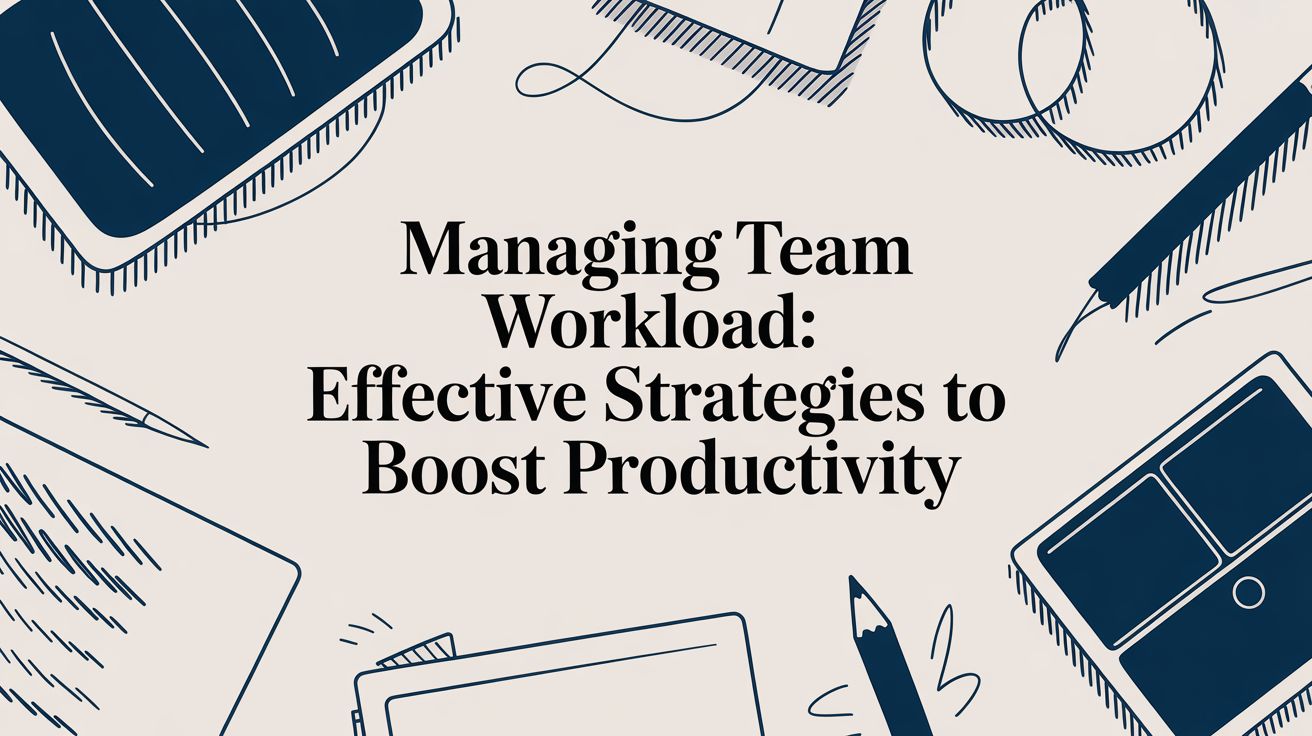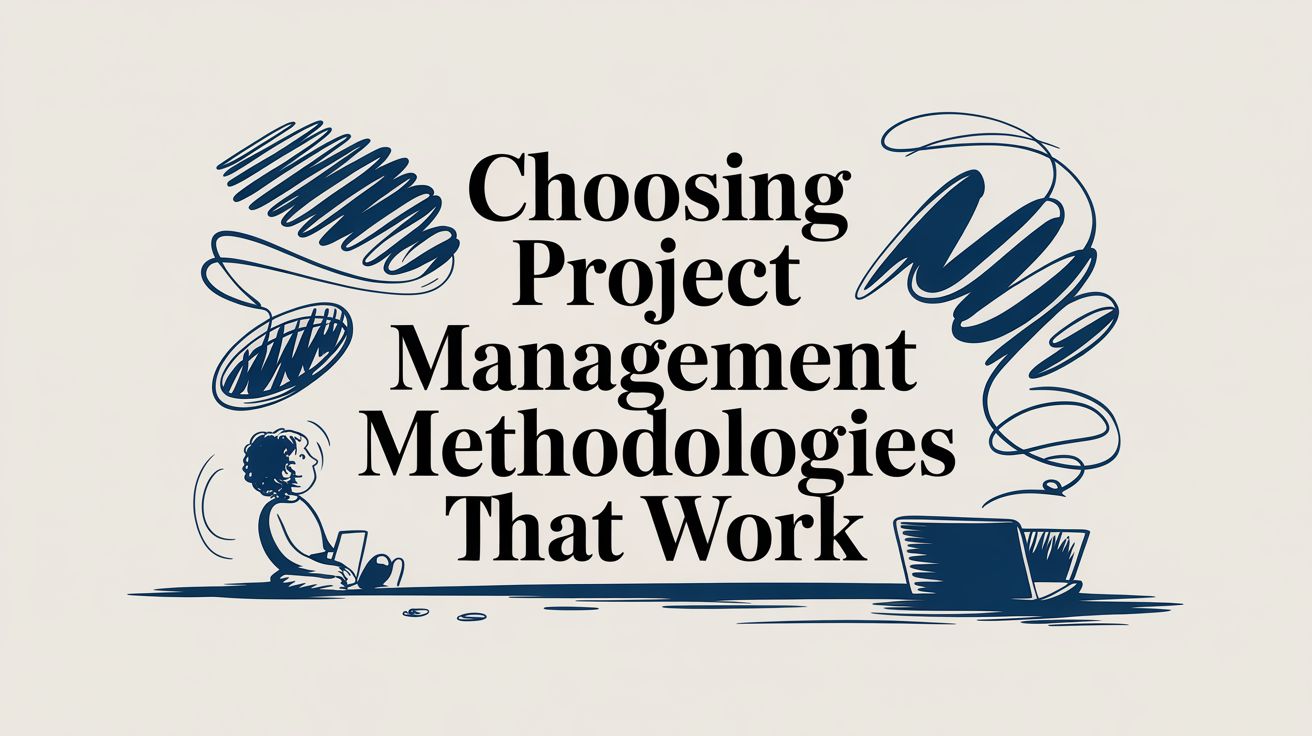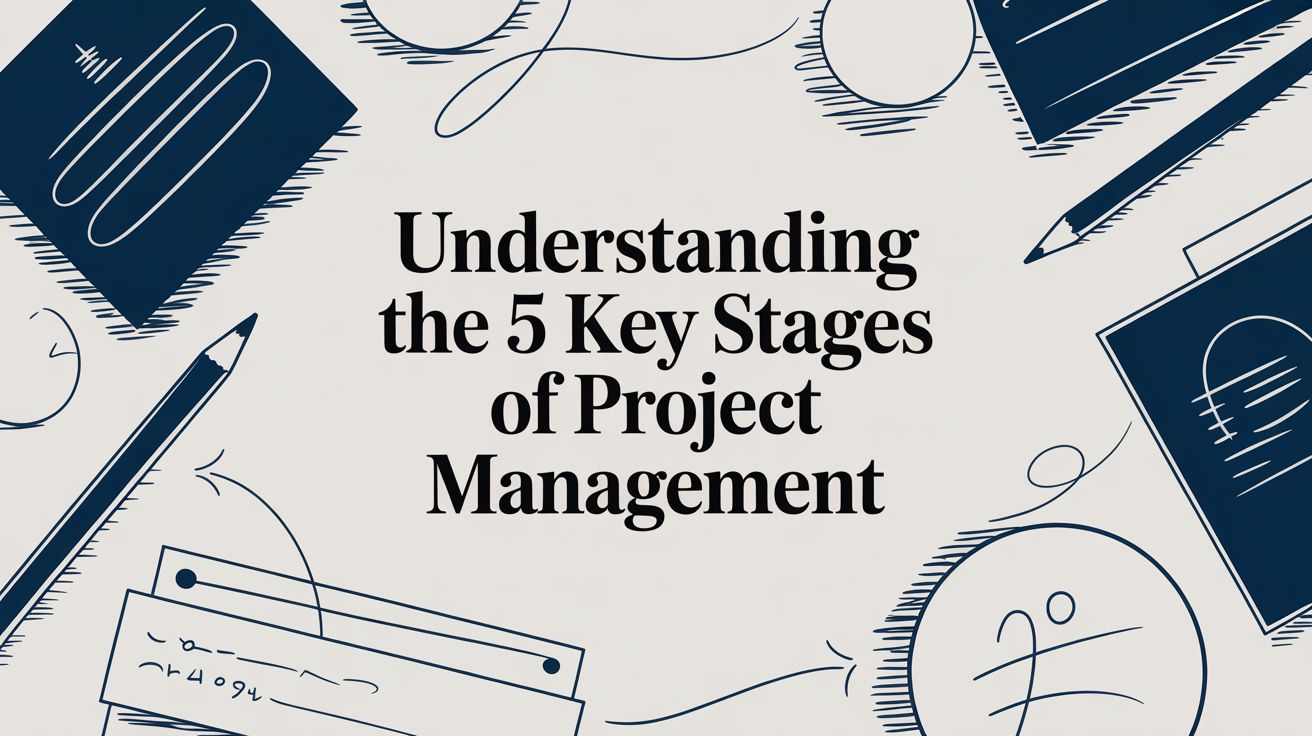The agile project management methodology is all about tackling projects in an iterative way, breaking them down into small, manageable cycles. Forget rigid, long-term planning; the focus here is on flexibility, customer collaboration, and continuous improvement. This allows teams to adapt to changes on the fly.
Understanding the Agile Project Management Methodology
Imagine trying to cook a gourmet meal. The traditional way would be to follow a rigid recipe from start to finish, with absolutely no room for deviation. The agile methodology, on the other hand, is more like tasting and adjusting the seasoning as you go. It's less a strict set of rules and more a flexible mindset focused on delivering real value, fast.
This approach works by dismantling large, complex projects into smaller, digestible pieces called iterations or sprints. Think of each cycle as a mini-project in its own right, complete with everything from planning and development to delivery.

A Shift from Plans to People
At its heart, Agile champions a fundamental move away from blindly following a pre-written plan. Instead, it places a premium on responding to feedback from customers and stakeholders throughout the entire process. This ongoing dialogue ensures the final product truly meets their needs, rather than just ticking boxes on an outdated brief.
This dynamic, collaborative method is a world away from more traditional, linear project management styles. To really get a handle on the differences, it’s worth taking a look at various project management methodologies to see how they stack up against each other.
Why Is Agile Gaining Momentum in the UK
Businesses are waking up to the benefits of this adaptable approach. Agile is quickly becoming the go-to strategy for UK organisations that need to speed up delivery and react quickly to market shifts. In fact, research from early 2025 shows 52% of British companies now prioritise Agile practices specifically to slash their time to market. It's a critical advantage that helps them get minimum viable products (MVPs) into customers' hands faster, especially in competitive industries.
The central idea is simple: deliver value incrementally, learn from feedback, and adapt continuously. This iterative loop minimises risk and maximises the chances of building something the customer actually wants.
This constant cycle of building, testing, and learning ensures that every step forward is informed by real-world data, not just assumptions made months ago at the project's outset.
The Heart and Soul of Agile: Its Core Values and Principles
To really get what makes agile tick, you have to look past the processes and get into its DNA. This is all laid out in four core values and twelve guiding principles from the original Agile Manifesto. Think of these less as rigid rules and more as a mindset—a completely different way of looking at work that puts people and flexibility front and centre.
These values are the compass that guides every decision an agile team makes. They signal a huge shift away from the traditional, step-by-step project management playbook. Let's break down what they actually mean in the real world.
The Four Core Values of Agile
The whole spirit of Agile is neatly summed up in four key statements. In each one, the idea on the left is valued more than the one on the right. This isn't to say the things on the right are useless, just that in a fast-moving environment, the ones on the left are what truly get you to the finish line.
Individuals and interactions over processes and tools: Agile bets on people. It trusts that the best ideas and solutions come from smart, motivated people actually talking to each other, not from forcing everyone to follow a stiff process or use a particular tool.
Working software over comprehensive documentation: In agile, the number one measure of progress is a product that actually works. Sure, documentation has a role, but the goal is to avoid getting bogged down in endless paperwork that just delays getting something valuable into the customer's hands.
Customer collaboration over contract negotiation: Instead of hammering out every single detail in a contract before you even start, agile brings the customer along for the ride. This partnership ensures the final product is what the customer really needs, not just what was written down months ago.
Responding to change over following a plan: Let's face it: things change. Market demands shift, user feedback comes in, and business priorities evolve. Agile is built for this. It gives teams the freedom to adapt based on new information, rather than being chained to a plan that's already out of date.
These values build a culture of adaptability. The aim isn't to perfectly execute a plan made in the past; it's to discover the best possible result through a continuous cycle of feedback and improvement.
This iterative approach means being ready to change course when you need to. A huge part of this is understanding the importance of pivoting when new information or market shifts tell you it's time for a new direction.
The Twelve Guiding Principles in Action
Backing up these values are twelve principles that offer more concrete guidance. They're the practical, "how-to" side of the agile philosophy, turning big ideas into the actions a team takes every day.
- Satisfy the Customer: Your top priority is to make the customer happy by delivering valuable work early and often.
- Welcome Changing Requirements: Change isn't a problem; it's an opportunity. Agile uses it to the customer's competitive advantage, even late in the game.
- Deliver Working Software Frequently: Deliver functional parts of the product in shorter timeframes, ideally a few weeks to a couple of months.
- Work Together Daily: Business folks and developers need to be in constant communication, working together throughout the project.
- Build Projects Around Motivated Individuals: Put the right people on the project, give them the support they need, and then trust them to get the job done.
- Use Face-to-Face Conversation: The best way to get information across is by talking to someone directly. It’s efficient and effective.
- Working Software is the Primary Measure of Progress: A functional product is the true sign that you're moving forward, not just a list of completed tasks.
- Promote Sustainable Development: The team should be able to maintain a steady pace of work indefinitely without burning out.
- Maintain Technical Excellence: Paying constant attention to good design and clean code makes the product stronger and easier to change later on.
- Simplicity is Essential: Keep it simple. The goal is to maximise the amount of work not done, cutting out anything that doesn’t add real value.
- Self-Organising Teams: The best ideas, requirements, and designs come from teams that have the autonomy to manage their own work.
- Reflect and Adjust Regularly: The team regularly stops to think about how they can work better, and then they tweak their process accordingly.
Comparing Agile Frameworks: Scrum vs Kanban
If the Agile methodology is the overall game plan, then frameworks are the specific plays your team runs to score. They give you the structure to turn Agile’s core ideas into real, tangible results. While there are a few out there, Scrum and Kanban are by far the most popular.
They both spring from the same Agile values, but they take very different routes to get the job done. Think of it less as "which one is better?" and more as "which one fits our team's rhythm?" Your project, your team, and your company culture will all point you towards the right fit.
The Structured Sprints of Scrum
Scrum is a highly organised framework built around short, repeating work cycles called sprints. A sprint usually lasts between one and four weeks, and in that time, the team commits to finishing a specific chunk of work they’ve pulled from a master list (the sprint backlog). The aim of every single sprint is to produce a small, working piece of the final product.
Picture a team building a new mobile app. Using Scrum, they might break the whole project down into two-week sprints. Before each sprint begins, they’d pick a few features from their main to-do list to focus on. For the next two weeks, that's their world. At the end, they should have a functional piece of the app to show for it, ready for feedback.
Scrum is quite prescriptive, with very specific roles and meetings:
- Roles: You have a Product Owner (the voice of the customer), a Scrum Master (the coach who keeps things running smoothly), and the Development Team (the people doing the hands-on work).
- Ceremonies: It’s all kept on track with regular meetings like Sprint Planning, Daily Scrums, Sprint Reviews, and Sprint Retrospectives. These aren't just chats; they're essential for keeping everyone aligned and constantly improving.
Scrum creates a powerful rhythm. The time-boxed sprints force focus and create regular opportunities for feedback. It’s a fantastic choice for complex projects where you know things will change, because every sprint gives you a chance to stop, look, and adjust your course.
This structured approach is a clear favourite; one report found that a massive 63% of agile practitioners use Scrum. It provides a steady cadence that helps teams deliver value, predictably.
The Continuous Flow of Kanban
Kanban, on the other hand, is all about flexibility and flow. It’s less about rigid cycles and more about visualising your workflow to get tasks from A to B as smoothly as possible. The name itself is Japanese for "visual card," which makes perfect sense because the heart of Kanban is the Kanban board. This board gives you a bird's-eye view of your entire process, usually with columns like "To Do," "In Progress," and "Done."
Imagine a post-production sound editing team. Their work—dialogue editing, sound mixing, final review—flows from one stage to the next. A Kanban board lets them see exactly where every task is at any given moment. Instead of working in fixed sprints, a team member simply grabs the next priority task from the list as soon as they have the capacity.
The main goal here is to improve efficiency by spotting and clearing out bottlenecks. The secret weapon for this is setting Work in Progress (WIP) limits. This means you cap the number of tasks allowed in any one stage. If the "In Progress" column has a WIP limit of three, nobody can start anything new until one of those three tasks is finished. It’s a simple but brilliant way to stop people from getting swamped and to shine a light on where work is piling up.
Key Differences at a Glance
The infographic below really nails the core difference between a sprint-based Scrum board and a continuous-flow Kanban board.
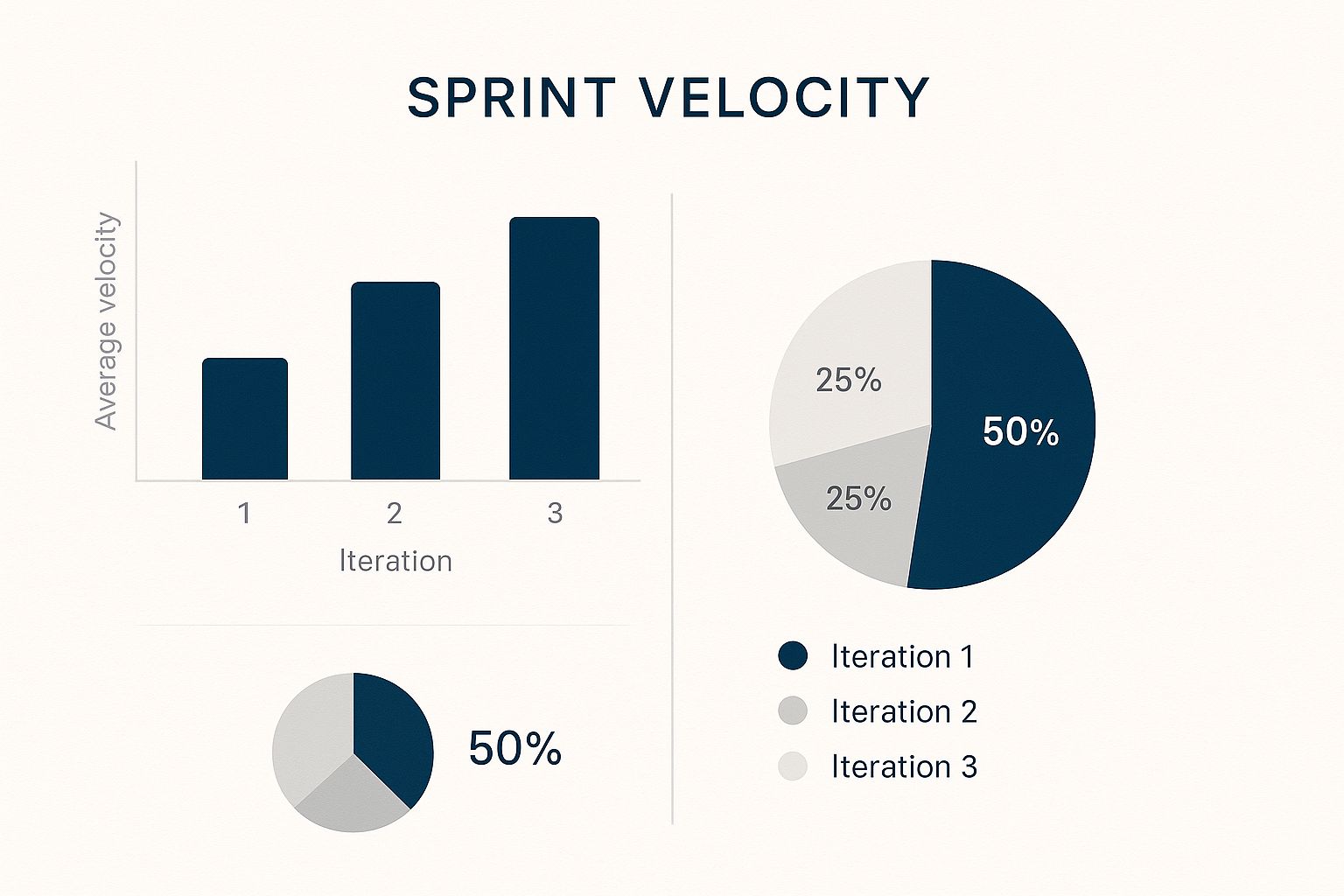
You can see Scrum's repeating cycle versus Kanban's straight, continuous path. It’s a perfect visual summary of how they operate.
Comparing Scrum and Kanban Frameworks
To make the choice clearer, it helps to put their core features side-by-side. Both are fantastic tools, but they solve different kinds of problems.
| Attribute | Scrum | Kanban |
|---|---|---|
| Cadence | Regular, fixed-length sprints (e.g., 2 weeks). | Continuous flow with no fixed timeboxes. |
| Roles | Prescribed roles: Product Owner, Scrum Master, Dev Team. | No prescribed roles; teams are flexible and can adapt. |
| Key Metrics | Velocity (how much work gets done per sprint). | Cycle Time (how long it takes one task to go from start to finish). |
| Change | Changes are generally avoided during an active sprint. | Changes can be made at any point as priorities shift. |
| Best For | Complex projects with evolving requirements and clear milestones. | Teams with a steady, continuous workflow like support or maintenance. |
Ultimately, there's no single "right" answer. Scrum's rigid structure can be a godsend for teams new to Agile or those tackling projects with big, chunky goals. Kanban, with its focus on flexibility, is often a better fit for teams in operational roles or creative workflows where tasks can be unpredictable. And of course, many teams end up mixing and matching elements from both, creating a hybrid that gives them the best of both worlds.
The Real-World Benefits of Adopting Agile
So, why are so many businesses making the switch to Agile? Forget the theory for a moment; the real attraction lies in the tangible results. Adopting an agile project management methodology isn't just about shuffling processes around—it translates directly into measurable gains that give a company a serious competitive edge.

It’s about unlocking strategic advantages. Businesses that truly embrace Agile often see faster product delivery, quicker reactions to market shifts, and teams that are far more engaged. It builds a culture of innovation and constant improvement.
Accelerated Time to Market
In today's fast-moving world, speed is everything. Agile’s iterative approach means teams aren't stuck waiting for one big launch at the end of a long, drawn-out project. Instead, they deliver working pieces of the product in short, consistent sprints.
Each sprint produces a potentially shippable part of the product. This lets companies get a minimum viable product (MVP) to actual users much faster, gathering vital feedback and generating value while the competition is still buried in planning documents.
By focusing on delivering value in every iteration, Agile lets you launch faster, test hypotheses in the real world, and start acquiring users or generating revenue earlier in the project lifecycle.
This rapid delivery cycle is a complete game-changer. It means you can jump on market opportunities with incredible speed, making sure your product stays relevant and one step ahead.
Improved Customer Satisfaction
At its heart, Agile is all about the customer. The whole methodology is built around short feedback loops that keep the customer in the loop throughout the entire process, not just at the start and finish. This collaborative spirit ensures the final product is actually what the customer wants and needs.
Think of an e-commerce company building a new checkout feature:
- Initial Sprint: The team develops a basic, functional version and shares it with a select group of customers.
- Feedback Loop: The users say the payment options feel limited and the layout is confusing.
- Next Sprint: The team immediately pivots. They prioritise adding more payment gateways and redesigning the flow for clarity, based directly on that user feedback.
This continuous conversation turns a simple idea into an intuitive, user-friendly tool that genuinely makes the customer's life easier—and boosts sales in the process. When you involve customers early and often, you slash the risk of building the wrong thing and dramatically increase the odds of creating a product they'll love.
Greater Adaptability and Reduced Risk
Traditional project management often chains teams to a rigid plan from day one. If the market suddenly shifts or a competitor drops a surprise feature, changing course can be painfully slow and expensive. The agile project management methodology, on the other hand, is built for change.
Because projects are broken down into small cycles, teams can hit pause, reassess their priorities, and adjust their direction at the end of every single sprint. This built-in flexibility is a powerful way to manage risk. It allows teams to respond to new information—whether it’s customer feedback, a technical roadblock, or a shift in company goals—without throwing the entire project off the rails.
This adaptability makes sure your resources are always pointed at what delivers the most value right now, minimising wasted effort on goals that are already out of date.
Your Guide to Implementing Agile in Your Team
Making the switch to an agile project management methodology can seem daunting, but it doesn't have to be a painful, top-to-bottom overhaul. A successful shift is less about a big-bang revolution and more of a steady, supported evolution. And it all starts with people, not processes.
First things first: you absolutely need genuine buy-in from your leadership. Agile isn't just a new set of rules for one team; it's a fundamental change in how the entire organisation views progress and defines success. Leaders need to be the biggest champions of this change, providing the resources and—just as importantly—the psychological safety for teams to experiment, learn, and even fail without fear.
Once leadership is on board, it's time to focus on the team itself. Just handing them a Scrum guide and wishing them luck won't cut it. They need proper training in the Agile mindset, grounding them in the core values and principles we talked about earlier. This makes sure they understand the why behind the new meetings and tasks, so they aren't just going through the motions.
Choosing Your Starting Framework
With the team prepped, you can pick a framework to start with. As we've covered, Scrum’s structured sprints are a great fit for complex projects with clear goals. On the other hand, Kanban’s continuous flow often works better for teams handling a constant stream of work, like a support or maintenance crew.
Don't feel like you're locked into one forever. Many teams begin with one framework and eventually create a hybrid system, borrowing bits and pieces from both to build something that perfectly fits their unique workflow. The key is to start with a simple, clear structure everyone can get behind.
The Power of a Pilot Project
Instead of trying to flip the entire department to Agile overnight, start small. Pick a single, relatively low-risk project to be your pilot. This gives your team a controlled space to practice the new methods, make mistakes on a small scale, and build up their confidence.
A successful pilot project is your best proof of concept. It delivers real results and creates internal champions who can advocate for a wider rollout. This helps the transition feel more like a grassroots movement than a top-down mandate.
Make sure you choose a team for this pilot that’s open-minded and enthusiastic. Their positive experience becomes a powerful story that can help win over more sceptical colleagues and build the momentum you need for broader adoption.
Defining Roles and Setting Up Visual Boards
Clarity is everything. Even if you aren't using the formal roles of Scrum, you need to define who is responsible for what. Who will prioritise the work (like a Product Owner)? Who will help clear away obstacles (like a Scrum Master)? Getting these questions answered early on prevents a lot of confusion later.
Next, you have to make the work visible. Whether it's a physical whiteboard covered in sticky notes or a digital tool, a visual board is non-negotiable. It acts as the single source of truth, showing what’s being worked on, who’s doing it, and what’s up next. This level of transparency is a cornerstone of the agile project management methodology, driving both accountability and communication. As you get your team started, understanding good agile software development documentation practices is also crucial for keeping everything clear.
Selecting the Right Software
While Agile is a mindset first and foremost, the right software can make a huge difference. The market for Agile project management tools is booming in the UK. Valued at roughly USD 5.9 billion globally in 2025, it’s projected to nearly triple by 2032. British companies are leaning on these tools to bridge the gap between Agile theory and daily practice, especially as 70% of project managers now report using AI-driven features for things like predictive analytics and risk forecasting. You can find out more about the growth of the Agile software market at coherentmarketinsights.com.
When you're choosing a tool, look for something intuitive and flexible. Your software should bend to your process, not the other way around. Look for features that support your chosen framework, make collaboration easier, and give you clear reports. The goal is a tool that feels like a natural part of your workflow. To get a better sense of how software can support your team, check out our guide on the role of integration in project management.
By focusing on these practical steps—getting buy-in, training the team, starting small, and picking the right tools—you can guide your team through a smooth and successful transition to Agile.
Navigating Common Agile Implementation Challenges
Let's be honest: switching to agile isn't like flipping a switch. While the benefits are huge, the path from traditional methods to a truly agile workflow is almost always bumpy. Getting it right means knowing what roadblocks to expect and having a plan to navigate them.
One of the first hurdles you'll likely face is resistance to change. It's human nature. Team members who are used to waterfall or other traditional methods might view the new workflows with a healthy dose of scepticism. This isn't just stubbornness; it's a reaction to unfamiliar processes and what can feel like a loss of control. The only way through this is to build trust and show them it works, one small step at a time.
Another major risk? Team burnout. The fast-paced, cyclical nature of agile, with its short sprints and constant deadlines, can feel relentless if you don't manage it carefully. An "always-on" culture is the quickest way to kill morale and quality, undoing all the efficiency you were trying to build in the first place.
Overcoming Resistance and Burnout
When you're up against resistance, the best strategy is to start small. Pick a pilot project and focus on getting a tangible win. Seeing is believing, and an early success story is your most powerful tool for winning over the sceptics. It’s also vital to create a space where people feel safe to ask questions or voice concerns without being shot down. Celebrate the small victories along the way to build momentum.
To prevent burnout, you have to commit to a sustainable pace. This isn’t just a nice-to-have; it's a core principle of agile. Sprints must be planned realistically, and it's the leader's job to shield the team from outside pressures that lead to overcommitment. Effectively managing your team’s workload is a non-negotiable for long-term success. You can dive deeper into practical strategies by learning more about managing team workload to keep your team healthy and productive.
True agility isn't about working faster; it's about working smarter. It means creating a rhythm that allows teams to deliver consistently and predictably over the long haul without sacrificing their well-being.
Finally, a common trap is letting scope creep disguise itself as flexibility. Agile is all about welcoming change, but that doesn't mean every new idea gets thrown into the current sprint. Without a strong Product Owner who can ruthlessly prioritise and protect the backlog, sprints can quickly descend into chaos.
The human element is always the trickiest part. Even as the UK works to close a skills gap in agile, project professionals are reporting higher stress levels from the pace of change. In fact, a staggering 37% of projects still fail because of unclear goals, which just goes to show how crucial strong leadership is. By anticipating these common challenges, you can steer your team toward a much more successful—and sustainable—agile future.
Frequently Asked Questions About Agile
As teams start digging into agile project management, a few common questions always seem to pop up. Let's clear up some of the usual points of confusion and build on what we've already covered.
Can Agile Be Used Outside of Software Development?
Absolutely. While agile got its start in the software world, its core ideas are incredibly flexible. Today, you’ll see it working wonders in marketing, product design, HR, and even construction.
At its heart, agile is about delivering work in small increments, listening to feedback, and being ready to change course. That’s a valuable approach for any complex project where you can’t predict everything from the start.
What Is the Biggest Mistake When Adopting Agile?
One of the most common traps is just going through the motions. Teams adopt the ceremonies—like daily stand-ups or sprint planning—without actually embracing the mindset behind them. This is what people call "cargo cult agile."
You can follow all the rules, but if there isn't a genuine shift towards collaboration, empowering your team, and always looking for ways to improve, you're missing the point. True agility is a cultural change, not just a new process.
The goal is not just to 'do' Agile, but to 'be' Agile. This means internalising the values of flexibility and customer collaboration, allowing the team to adapt thoughtfully rather than just perform rituals.
How Are Budgets Managed in an Agile Project?
This is a big one. Agile doesn't throw budgets and deadlines out the window; it just looks at them differently.
Instead of trying to fix the project's entire scope upfront, an agile approach often fixes the time (like the length of a sprint) and the cost (the size of the team). From there, the team focuses on delivering the most valuable features they can within those constraints. This ensures that you’re always prioritising what matters most and that you always have a usable product to show for your investment.
Ready to bring agile clarity to your post-production workflows? See how freispace can help you manage projects, track resources, and deliver on time, every time. Discover freispace today.

